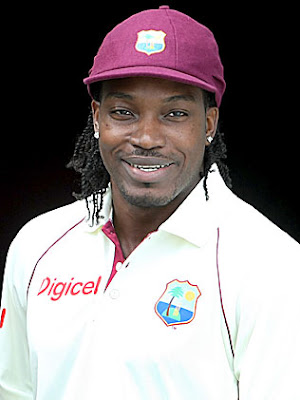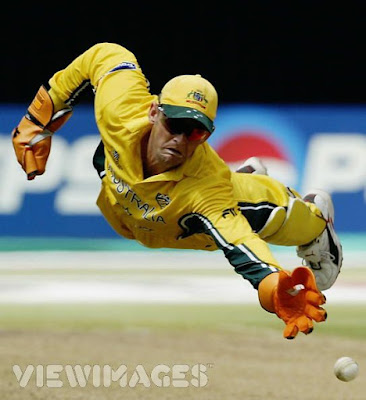Brett Lee Biography:
Brett Lee entered the world on November 8, 1976. He is the second of three sons born to Bob and Helen Lee; his siblings being older brother Shane, and younger brother Grant.
Brett grew up in Wollongong, New South Wales where the young Lee family had chosen to settle. His father worked at BHP steelworks, and he continues to work there today as a qualified metallurgist.
Soccer, basketball and skiing in the Snowy Mountains were three of the early sports that Brett and his brothers were introduced to during the school holidays, and on the rare times they were indoors, they were encouraged to play the piano. According to Helen, they were all good, but Brett didn't have time to learn because he couldn't sit still for 5 minutes!
Fortunately, Brett loved his cricket and showed an instant talent for it - all three Lee boys did. In Brett's first "real" game of cricket, when Brett was just 9 years old, he took 6-0 in one over, all bowled (side note: if that wasn't a sign from above, then I don't know what is!). Some of the opposition team members started crying, and soon enough, parents from other opposition teams started complaining that Brett was just too fast! Even Brett's own mother felt sorry for the opposition!
Brett loved seeing batsmen backing away and stumps flying - a common sight against his bowling at this age - but he wasn't prepared for the damage a cricket ball could do. He claimed his first "victim" at the age of 12. As Brett says, "I remember hearing this really loud crack and I saw him stumbling. There was blood all over the pitch. I felt sick; it shocked me. As much as I wanted to bowl as fast as I could at that age, seeing the results made me think I'd gone too far."
The next few years saw Brett continue his steady rise through the cricketing ranks culminating in his selection in the Australian Under-19 team for a tour of India in March '94. A back injury soon after forced Brett to lay low for a while, but with his unwavering determination and hard work, he ensured that the injury wasn't going to be the be all and end all of his cricketing career.
In '97-98, Brett's efforts were rewarded when he was selected to make his first-class debut for NSW in a Sheffield Shield match against Western Australia. It just took the one match for Brett to make an impact on the state scene, and the bruised and beaten Warriors team returned home to WA saying that the NSW Blues had perhaps discovered the fastest bowler in Australia.
Just one month later, Brett received higher honours when he was chosen to play for Australia "A" against South Africa. He took two wickets in the match, but more significantly, he managed to screw up his back again. The stress fractures from his previous injury had re-opened. This time the recovery took much longer and he was put in a brace for more than three months. "It went from my head to my bum, I looked like Frankenstein, and was bascially off my feet for 14 weeks. The rest of the season was a write off."
But things weren't all doom and gloom for Brett with his second back injury. Six months earlier he received a job offer from Barclay's Menswear store to sell suits. Brett jumped at the opportunity. His employer, Richard Bowman, says, "He was taught all about sizes, fittings, fabrics and techniques. He fell straight into it. He loved clothes, and I allowed him to dress in our suit and shirts. That was the beginning of the walking public relations machine."He continues, "Schoolgirls go nuts over him." "...we once had a mini-riot out the front of the shop...there were girls screaming...when I heard the noise I immediately thought there had to be a pop star somewhere. I can understand how young girls adore him. He's just so clean and keen. So pure."
After his 21st birthday, Brett moved to Sydney to be closer to work. He shared an flat with NSW cricketer Rod Davison near the city.
Having spent the following season regaining the lost strength in his back and playing for his club and state side, Brett was soon nearly firing at his brilliant best. The next 1999-2000 season proved to be an good one for Brett. He had several great performances taking wickets at an impressive strike rate. He was again rewarded for his efforts by being named in the Australian Test squad to face Pakistan in the third and final Test at the WACA. He did not make the final playing XI and was given the 12th man duties. But Brett being Brett saw it as a positive thing because he "had the chance to get a feel of the Test match, the team, and the dressing room without the pressure of having to perform."
Boxing Day Test 2000 - Brett makes his Test debut! He takes a wicket in his very first over, another soon after, and then takes three in his fourteenth over! 5 wickets on debut - a fairy tale start!
His ODI debut was also a memorable one, with big brother, Shane also being named in the squad - their first ODI for Australia!
Since then, apart from a couple of injuries, the rise of Brett Lee as a world-class cricketer has continued at a meteoric rate. He has continued to tear the hearts out of the opposition teams with his fearsome fast bowling, and has proved to be a useful tail-end batsmen with the ability to whack huge sixes and provide entertainment for the crowds.
Brett's status these days, is like that of a superstar. He resides in the trendy Pyrmont area close to Sydney. He also has endorsements and sponsorship offers being thrown at him left, right and center. But there has no better indication of Brett's popularity than when he was named runner-up in Cleomagazine's annual Bachelor of the Year competition in 2000.
On June 3, 2006, Brett married Elizabeth (Liz) Kemp in Fitzroy Falls on a private estate belonging to Alan Jones. They have a son, Preston Charles Lee (born on November 16, 2006). Brett and Liz confirmed their separation in August 2008. While rumours quickly surfaced, the reasons for split are private.
Following the retirement of bowling great, Glenn McGrath, Brett became the spearhead of the Australian bowling attack in 2007/08 and he has since produced the best bowling of his career. He has stepped up and revelled in the responsibility of being the main man, so much so that he has put many an Opposition on the back foot, such is the respect they have for his speed and accuracy.
At the peak of his powers, in February 2008 Brett was voted Australia's Test Player of the Year and claimed the Allan Border Medal ahead of opening batsman Matthew Hayden and captain Ricky Ponting. He has snared five wickets in an inning 9 times, while he took a career best 8 for 110 against the West Indies in Antigua in 2008. Brett attributes his new found success to patience and maturity, and the likes of Mitchell Johnson and Shaun Tait name Brett as their mentor.
On the 22nd of November, 2008 at the 'Gabba, Brett reached another major milestone in his Test cricket career by claiming his 300th wicket. In claiming the scalp of J. M. How, he became only the fourth Australian player – after Dennis Lillee (who took a total of 355 wickets), Glenn McGrath (563) and Shane Warne (708) – to achieve the milestone.
Brett is an enthusiastic and motivated sportsman that is grateful for all of the opportunities that have come his way. He remains a grounded person who is generous with his time.
Outside of Cricket Brett has a number of other interests. He has a love of music and plays in a band, 'White Shoe Theory' and will release their album in 2011. He was formerly a member of two other bands, 'Six and Out' and 'The Gas'. He first launched his music in India with Bollywood star, Asha Bhosle, and their single, "You're the One" (which he co-wrote the lyrics) went to No. 1 in the Indian music charts.
Brett has also launched his own fashion label whilst still finding time whenever possible to fit in a spot of fishing.
Brett Lee
Brett Lee
Brett Lee
Brett Lee
Brett Lee
Brett Lee
Brett Lee
Brett Lee
Brett Lee
Brett Lee Hattrick:
Brett Lee FASTEST OVER SEEN IN NEW ZEALAND 2005:
















